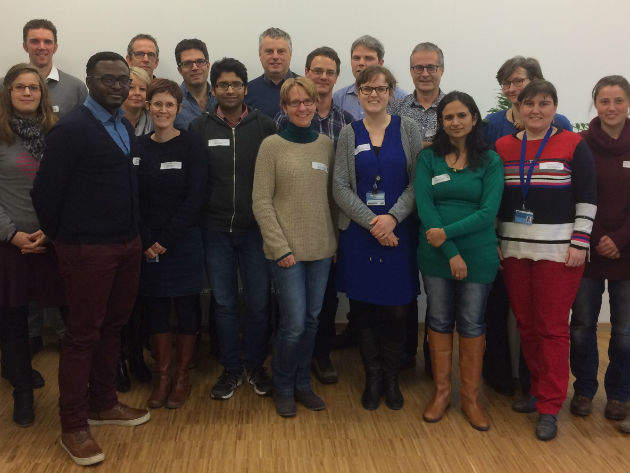

Rabies and yellow fever claim tens of thousands of lives every year and although vaccines do exist, they are either expensive or in short supply, and need to be transported and stored at controlled temperatures. Now, a consortium led by KU Leuven aims to tackle all of these issues by developing a cheap, temperature-stable and easy-to-produce vaccine against both diseases simultaneously.

Discover B2B Marketing That Performs
Combine business intelligence and editorial excellence to reach engaged professionals across 36 leading media platforms.
With a near 100% fatality rate, rabies is one of the deadliest diseases on Earth, claiming an estimated 58,000 lives per year, most of these in remote areas of Africa and Asia and over half of them children. Many people are still not vaccinated, because not only are the vaccines very expensive, they need to be transported via the cold chain and require three doses if given prophylactically, and up to five to be effective after exposure, depending on the severity of the bite.
Meanwhile, the situation for mosquito-borne yellow fever, which can cause a life-threatening infection with jaundice, systemic bleeding, shock and organ failure, is equally dire. Although safe and highly efficient prophylactic vaccines are available, an estimated 30,000 people die from the disease each year because of inadequate supplies and the need for trained staff and a cold chain.
Funded by a €4.1m grant from the European Union’s Horizon 2020 Research and Innovation Programme, the RABYD-VAX Consortium combines the expertise of researchers from four different European institutions. Led by Johan Neyts at the KU Leuven Laboratory of Virology, it hopes to address these issues by developing a vaccine that protects against both rabies and yellow fever, could be included in routine childhood vaccinations, and is cheap, temperature-stable, easy-to-produce on a large scale and can be administered without a needle.
The platform
The vaccine will be created using a novel platform technology, developed by KU Leuven’s Dr Kai Dallmeier, called PLLAV, or ‘plasmid-launched live-attenuated vaccine’. Essentially, the team has cloned the commercial yellow fever genome into a bacterial artificial chromosome, or DNA plasmid, which can then have other antigens – even those not related to yellow fever – inserted into this genome and trigger immunity against them.

US Tariffs are shifting - will you react or anticipate?
Don’t let policy changes catch you off guard. Stay proactive with real-time data and expert analysis.
By GlobalData“Our technology combines the advantages of live-attenuated vaccines and DNA vaccines without dragging along their drawbacks,” explains RABYD-VAX’s project manager Lotte Coelmont, adding that one of the most important advantages of the PLLAV technology, compared to other commercially available vaccines, is that it doesn’t need a cold chain due to the physical and genetic stability of DNA-based vaccines. Moreover, vaccines can be produced in large volumes in fermenters, avoiding the need for cell cultures or embryonated chicken eggs, and they can be administered needle-free.
The project
At present, the team is five months into the project and everything is on track, according to Coelmont. “The first step was to clone the rabies antigen inside the yellow fever genome of our technology. If we hadn’t come up with a good construct that replicated well, the rest of the project would have been jeopardised,” she explains. “We are now on the second generation of constructs, which replicated even better than the first, so we hope that by summer, our research partners can start testing these for immunogenicity.”
After that, the team will move onto the next set of tests, designed to gain deeper insights into the vaccine’s immune response against the rabies virus, as well as exploring the potential for the rabies-yellow fever vaccine to protect against other viruses in the same family as rabies. “Rabies belongs to the lyssavirus group and we’d ultimately like to be able to protect against other rabies strains that may pop up in the future,” Coelmont notes.
During the four years of the RABYD-VAX project, the researchers also hope to gain novel insights into the PLLAV technology and its potential to target indications besides rabies. There may also be the possibility to use a different virus – in the same family as yellow fever – as the backbone for the technology.
“Zika virus and Japanese encephalitis belong to the same genus of viruses as yellow fever – they are all flaviviruses,” Coelmont explains. “In theory we could change the backbone of the PLLAV technology to one of these and combine different indications depending on the region of vaccine application.”
For example, Japanese encephalitis is common in Asia, while yellow fever is more frequent in Africa and Latin America. “We could combine Japanese encephalitis with rabies for Asia and yellow fever with rabies for the other regions,” Coelmont says. Also a mosquito-borne virus, there are an estimated 68,000 clinical cases of Japanese encephalitis every year. The fatality rate is up to 30% and more than 3 billion people are at risk of infection.
The ultimate goal
By the end of the RABYD-VAX project, the team hopes to reach the advanced pre-clinical stage of vaccine development, but it will be at least 10 years before the first combined rabies and yellow fever vaccine will be available to patients. “As part of our four-year project, we have a contractor that will do a market study to find out what we will need to have in place to go to the clinical phase,” Coelmont explains. “Then we can move forward towards clinical trials, but a lot depends on how the regulatory approval process goes.”
She has no doubt it will be worth the wait. “Today, patients need to return to healthcare facilities up to five times for rabies vaccines, which is just not possible for many people,” she stresses. “We are aiming for a one-dose rabies-yellow fever childhood vaccine, which would be integrated into the standard vaccination programme of endemic regions and administered at around 9 months. Patients would then ideally have lifelong protection against rabies.”





